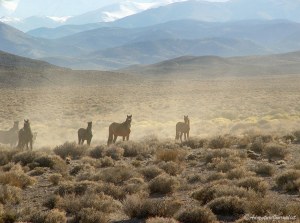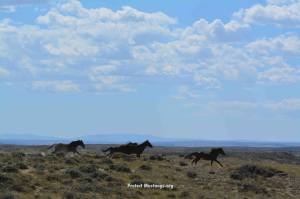Bad Romance?
Cliven Bundy rides his horse waving the American flag. He’s a Fox News hero who refused to pay fees and fines for illegally grazing his cows on federal lands for 20 years and then participated in an armed standoff with law enforcement, a frightening and fraught encounter for which he’s never been charged. He’s a cowboy hero, an icon of the rugged individualist, a living piece of the American Dream. Though he fell off his pedestal by blathering racism in the media’s glare, he still commands a lot of sympathy either consciously with right-wing rurals or, worse, unconsciously in the minds of everybody who wants to be, or at least preserve, the American cowboy.
And who doesn’t love the dashing vision of a cowboy, tall in the saddle on his handsome horse, splashes through a sunlit stream as he herds those little dogies along? Methinks, perhaps, the 80 percent of wildlife species that depend on riparian areas, a mere two percent of the land in the intermountain states. Cow-trampled, muddied streams with no overhanging grasses leave these once lush areas with a fraction of the biodiversity they evolved with. The livestock impacts of upland aspen and sagebrush steppes decimate the complexity of the delicate interplay between life and precious water in these drier, more prevalent ecosystems, leaving bare ground that blows away causing even more problems with snowmelt at high elevations. Meanwhile, public lands grazing has cost taxpayers over $1 billion in the last decade, and, as Christopher Ketcham reports in the New Republic this week, livestock are draining the arid West as the historic drought deepens.
There’s nothing wrong with a myth. It’s only harmful if it supersedes reason in decision-making. And there’s the rub. Though public lands ranchers raise only 3% of the nation’s beef and though they represent only a small fraction of the economies in their states, the livestock industry holds outsized power in the West. In Utah, county commissioners influence elections of party convention delegates, the folks who determine who makes it to the ballot. Or not. Like, for instance, the popular incumbents Sen. Bob Bennett and Gov. Olene Walker, who both enjoyed big approval ratings even as the party faithful refused to nominate them to the ballot. Ranchers disgruntled by Bureau of Land Management or Forest Service regulators can call Sen. Orrin Hatch to complain–and he’ll respond! By telling the agencies to stifle the enforcing officers or dismiss them. States cut education budgets but lavishly fund departments of agriculture that serve less to protect the public’s food supply than to support agriculture interests, economic and cultural. One of my favorite campaigns in Utah is a series of posters and PSAs that say “If their way of life goes away, what will happen to ours?” (Where’s the save-the-publishers campaign??)
The myth of the rugged, handsome cowboy is not serving us well. Not economically or ecologically. But we need myth. We crave it. We could replace it with a new romance, a new myth that captures the spirit of freedom and space. How about we trade the cowboy for his horse? The BLM
estimates that there are fewer than 50,000 feral horses on public lands, a trifle compared to the millions of cows grazing at public expense. Of course, ranchers complain that the wild horses are taking the forage from livestock and damaging the landscape–and on that last point the environmental community agrees. On the other hand, tens of thousands of horse lovers advocate passionately for the horses to run free on our landscapes. In 2013, the Utah BLM office received nearly 20,000 letters in support of the nonnative equines. And they are lovely. People love them, and the damage they do is minimal compared to that of livestock on public lands. How about we scrap the cowboy and replace him with the horse?
Posted on February 6, 2015, in Wild Lands and tagged Cliven Bundy, cowboy myth, federal land managers, public lands grazing, wild horses, wildlife. Bookmark the permalink. 5 Comments.




I’ve got an even better idea. Why don’t we trade in the cow and most of the horse for a healthy population of all of the native constituents of those ecosystem. Let’s let pronghorn, mule deer, prairie dogs, sage sparrow, least chub and a whole host of other native constituents that would thrive in a restoration of these degraded ecosystems shine. No rational ecologist would want these non-native domestic animals to be a dominant species in such any ecosystem. It is only our egocentric human view of what an ecosystem should look like that allows it to be so.
LikeLiked by 1 person
That is, no question, the best idea, Jay. But it’s a tough sell when the cowboy myth looms, large and pervasive, in the American psyche. I’m thinking we could substitute the image and symbolism of “wild” horses for the Marlboro man to greater effect than trying to pitch a healthy ecosystem, rich with life. A lush riparian area–or even its most photogenic fauna–just doesn’t seem to be able to compete with the cowboy for sympathy, power, or policy.
LikeLike
Reblogged this on Torrey House Press and commented:
THP is leaning toward creating some works on wild horses. Here Kirsten takes a first look.
LikeLike
Thanks for writing this, Kirsten! As someone who lives in Alaska, I know too well how myths saturate the political arena and how the very myths we cling to are the ones that end up stabbing us in the behind. The romantic notion of the wild west and the cowboy is the backbone of who we are as a country, but in reality it was a pretty hard and miserable life for most involved (especially women and native populations, but that’s another story, eh?). Cheers and thanks again,
LikeLiked by 1 person
Reality and romance have such a tough time co-existing! The stories of women and native people in the idyllic West receive too little attention. We (Torrey House Press, that is) were proud to publish Barbara Richardson’s rich novel,Tributary, which followed an orphaned young woman’s path away from polygamy and towards independence, and we’d love to do more. While there’s often little truth in myth, there’s often the greatest truth in story. Thanks so much for writing!
LikeLike